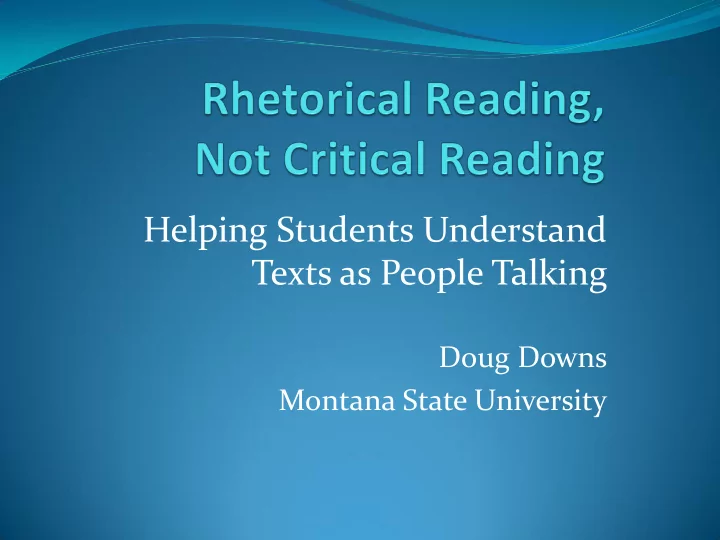

Helping Students Understand Texts as People Talking Doug Downs Montana State University
One-Minute Write Name two top- priority weaknesses in students’ reading Name a particular strength in students’ reading Then compare notes with your neighbors.
Rhetorical Reading Reading that emphasizes writer intention and motivation. Reading for context to complete a communicative “contract.” Reading that attends to what a text does — what it is meant to and needs to accomplish ( exigence ) for a given set of writers and readers ( rhetors ) in a particular rhetorical situation (historical and material context, activity system, and constraints).
Reading as Interaction Rhetorical reading is constructive Rhetorical reading is purposive Rhetorical reading attends to the exigence of the writing and reading moments (what needs call these discursive acts into being), the expectations, values, and needs of the text’s intended (and unintended) readers, the writer’s motivations , and the materio-historical and ideological constraints encountered and imposed by the writer’s circumstance and readers. The activity system, history, and materialities the text emerges from and within
Instead we teach “critical” reading Tends to focus on principles of argumentation derived from formal logic, depersonalized and removed from context — e.g., thesis, persuasive appeals, fallacies Tends to imagine meaning as fixed and texts as stable Tends to deploy a conduit metaphor for textuality: transmission of a meaning separate from the language used to transmit it, from writer A to reader B, focusing on clear, unaltered sending and receiving Tends to define reading in terms of meaning, logic, and persuasion (says/means rather than does)
Texts to Play With http://jetcitygastrophysics.com/
Strategies for Teaching Rhetorical Reading 1. Change the questions and expectations You’re not teaching decoding a message and critiquing it; you’re teaching tracing and participating in an interaction. Students look for what we tell them to look for.
Strategies for Teaching Rhetorical Reading 2. Be transparent How do you read a given text? How well do you know your own actual behaviors with texts and reading? Are you avoiding double standards?
Strategies for Teaching Rhetorical Reading 3. Help students see texts as people talking ??
Strategies for Teaching Rhetorical Reading 4 . Monitor students’ actual reading practices Trace markup Trace time Trace vocab
Strategies for Teaching Rhetorical Reading 5. Work with students where they are Relevance and engagement
Recommend
More recommend